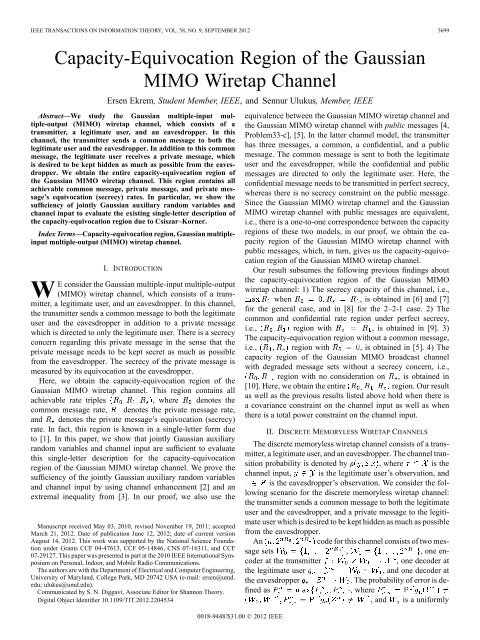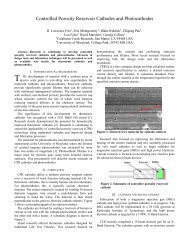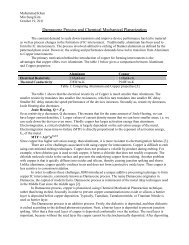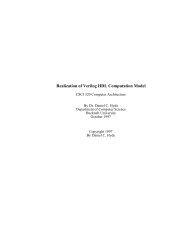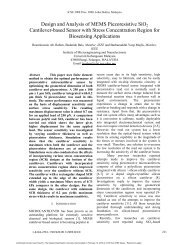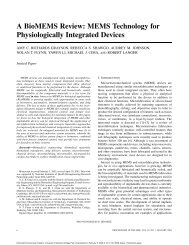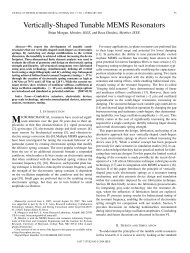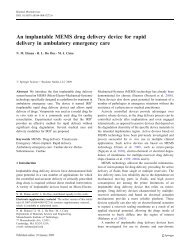Capacity-Equivocation Region of the Gaussian MIMO Wiretap ...
Capacity-Equivocation Region of the Gaussian MIMO Wiretap ...
Capacity-Equivocation Region of the Gaussian MIMO Wiretap ...
You also want an ePaper? Increase the reach of your titles
YUMPU automatically turns print PDFs into web optimized ePapers that Google loves.
IEEE TRANSACTIONS ON INFORMATION THEORY, VOL. 58, NO. 9, SEPTEMBER 2012 5699<br />
<strong>Capacity</strong>-<strong>Equivocation</strong> <strong>Region</strong> <strong>of</strong> <strong>the</strong> <strong>Gaussian</strong><br />
<strong>MIMO</strong> <strong>Wiretap</strong> Channel<br />
Ersen Ekrem, Student Member, IEEE, and Sennur Ulukus, Member, IEEE<br />
Abstract—We study <strong>the</strong> <strong>Gaussian</strong> multiple-input multiple-output<br />
(<strong>MIMO</strong>) wiretap channel, which consists <strong>of</strong> a<br />
transmitter, a legitimate user, and an eavesdropper. In this<br />
channel, <strong>the</strong> transmitter sends a common message to both <strong>the</strong><br />
legitimate user and <strong>the</strong> eavesdropper. In addition to this common<br />
message, <strong>the</strong> legitimate user receives a private message, which<br />
is desired to be kept hidden as much as possible from <strong>the</strong> eavesdropper.<br />
We obtain <strong>the</strong> entire capacity-equivocation region <strong>of</strong><br />
<strong>the</strong> <strong>Gaussian</strong> <strong>MIMO</strong> wiretap channel. This region contains all<br />
achievable common message, private message, and private message’s<br />
equivocation (secrecy) rates. In particular, we show <strong>the</strong><br />
sufficiency <strong>of</strong> jointly <strong>Gaussian</strong> auxiliary random variables and<br />
channel input to evaluate <strong>the</strong> existing single-letter description <strong>of</strong><br />
<strong>the</strong> capacity-equivocation region due to Csiszar–Korner.<br />
Index Terms—<strong>Capacity</strong>-equivocation region, <strong>Gaussian</strong> multipleinput<br />
multiple-output (<strong>MIMO</strong>) wiretap channel.<br />
I. INTRODUCTION<br />
WE consider <strong>the</strong> <strong>Gaussian</strong> multiple-input multiple-output<br />
(<strong>MIMO</strong>) wiretap channel, which consists <strong>of</strong> a transmitter,<br />
a legitimate user, and an eavesdropper. In this channel,<br />
<strong>the</strong> transmitter sends a common message to both <strong>the</strong> legitimate<br />
user and <strong>the</strong> eavesdropper in addition to a private message<br />
which is directed to only <strong>the</strong> legitimate user. There is a secrecy<br />
concern regarding this private message in <strong>the</strong> sense that <strong>the</strong><br />
private message needs to be kept secret as much as possible<br />
from <strong>the</strong> eavesdropper. The secrecy <strong>of</strong> <strong>the</strong> private message is<br />
measured by its equivocation at <strong>the</strong> eavesdropper.<br />
Here, we obtain <strong>the</strong> capacity-equivocation region <strong>of</strong> <strong>the</strong><br />
<strong>Gaussian</strong> <strong>MIMO</strong> wiretap channel. This region contains all<br />
achievable rate triples , where denotes <strong>the</strong><br />
common message rate, denotes <strong>the</strong> private message rate,<br />
and denotes <strong>the</strong> private message’s equivocation (secrecy)<br />
rate. In fact, this region is known in a single-letter form due<br />
to [1]. In this paper, we show that jointly <strong>Gaussian</strong> auxiliary<br />
random variables and channel input are sufficient to evaluate<br />
this single-letter description for <strong>the</strong> capacity-equivocation<br />
region <strong>of</strong> <strong>the</strong> <strong>Gaussian</strong> <strong>MIMO</strong> wiretap channel. We prove <strong>the</strong><br />
sufficiency <strong>of</strong> <strong>the</strong> jointly <strong>Gaussian</strong> auxiliary random variables<br />
and channel input by using channel enhancement [2] and an<br />
extremal inequality from [3]. In our pro<strong>of</strong>, we also use <strong>the</strong><br />
Manuscript received May 03, 2010, revised November 19, 2011; accepted<br />
March 21, 2012. Date <strong>of</strong> publication June 12, 2012; date <strong>of</strong> current version<br />
August 14, 2012. This work was supported by <strong>the</strong> National Science Foundation<br />
under Grants CCF 04-47613, CCF 05-14846, CNS 07-16311, and CCF<br />
07-29127. This paper was presented in part at <strong>the</strong> 2010 IEEE International Symposium<br />
on Personal, Indoor, and Mobile Radio Communications.<br />
The authors are with <strong>the</strong> Department <strong>of</strong> Electrical and Computer Engineering,<br />
University <strong>of</strong> Maryland, College Park, MD 20742 USA (e-mail: ersen@umd.<br />
edu; ulukus@umd.edu).<br />
Communicated by S. N. Diggavi, Associate Editor for Shannon Theory.<br />
Digital Object Identifier 10.1109/TIT.2012.2204534<br />
0018-9448/$31.00 © 2012 IEEE<br />
equivalence between <strong>the</strong> <strong>Gaussian</strong> <strong>MIMO</strong> wiretap channel and<br />
<strong>the</strong> <strong>Gaussian</strong> <strong>MIMO</strong> wiretap channel with public messages [4,<br />
Problem33-c], [5]. In <strong>the</strong> latter channel model, <strong>the</strong> transmitter<br />
has three messages, a common, a confidential, and a public<br />
message. The common message is sent to both <strong>the</strong> legitimate<br />
user and <strong>the</strong> eavesdropper, while <strong>the</strong> confidential and public<br />
messages are directed to only <strong>the</strong> legitimate user. Here, <strong>the</strong><br />
confidential message needs to be transmitted in perfect secrecy,<br />
whereas <strong>the</strong>re is no secrecy constraint on <strong>the</strong> public message.<br />
Since <strong>the</strong> <strong>Gaussian</strong> <strong>MIMO</strong> wiretap channel and <strong>the</strong> <strong>Gaussian</strong><br />
<strong>MIMO</strong> wiretap channel with public messages are equivalent,<br />
i.e., <strong>the</strong>re is a one-to-one correspondence between <strong>the</strong> capacity<br />
regions <strong>of</strong> <strong>the</strong>se two models, in our pro<strong>of</strong>, we obtain <strong>the</strong> capacity<br />
region <strong>of</strong> <strong>the</strong> <strong>Gaussian</strong> <strong>MIMO</strong> wiretap channel with<br />
public messages, which, in turn, gives us <strong>the</strong> capacity-equivocation<br />
region <strong>of</strong> <strong>the</strong> <strong>Gaussian</strong> <strong>MIMO</strong> wiretap channel.<br />
Our result subsumes <strong>the</strong> following previous findings about<br />
<strong>the</strong> capacity-equivocation region <strong>of</strong> <strong>the</strong> <strong>Gaussian</strong> <strong>MIMO</strong><br />
wiretap channel: 1) The secrecy capacity <strong>of</strong> this channel, i.e.,<br />
when , is obtained in [6] and [7]<br />
for <strong>the</strong> general case, and in [8] for <strong>the</strong> 2–2-1 case. 2) The<br />
common and confidential rate region under perfect secrecy,<br />
i.e., region with , is obtained in [9]. 3)<br />
The capacity-equivocation region without a common message,<br />
i.e., region with , is obtained in [5]. 4) The<br />
capacity region <strong>of</strong> <strong>the</strong> <strong>Gaussian</strong> <strong>MIMO</strong> broadcast channel<br />
with degraded message sets without a secrecy concern, i.e.,<br />
region with no consideration on , is obtained in<br />
[10]. Here, we obtain <strong>the</strong> entire region. Our result<br />
as well as <strong>the</strong> previous results listed above hold when <strong>the</strong>re is<br />
a covariance constraint on <strong>the</strong> channel input as well as when<br />
<strong>the</strong>re is a total power constraint on <strong>the</strong> channel input.<br />
II. DISCRETE MEMORYLESS WIRETAP CHANNELS<br />
The discrete memoryless wiretap channel consists <strong>of</strong> a transmitter,<br />
a legitimate user, and an eavesdropper. The channel transition<br />
probability is denoted by ,where is <strong>the</strong><br />
channel input, is <strong>the</strong> legitimate user’s observation, and<br />
is <strong>the</strong> eavesdropper’s observation. We consider <strong>the</strong> following<br />
scenario for <strong>the</strong> discrete memoryless wiretap channel:<br />
<strong>the</strong> transmitter sends a common message to both <strong>the</strong> legitimate<br />
user and <strong>the</strong> eavesdropper, and a private message to <strong>the</strong> legitimate<br />
user which is desired to be kept hidden as much as possible<br />
from <strong>the</strong> eavesdropper.<br />
An code for this channel consists <strong>of</strong> two message<br />
sets , ,oneencoder<br />
at <strong>the</strong> transmitter , one decoder at<br />
<strong>the</strong> legitimate user , and one decoder at<br />
<strong>the</strong> eavesdropper . The probability <strong>of</strong> error is defined<br />
as ,where<br />
,and is a uniformly
5700 IEEE TRANSACTIONS ON INFORMATION THEORY, VOL. 58, NO. 9, SEPTEMBER 2012<br />
distributed random variable in . We note that<br />
corresponds to <strong>the</strong> common message that is transmitted to<br />
both <strong>the</strong> legitimate user and <strong>the</strong> eavesdropper, and denotes<br />
<strong>the</strong> private message sent only to <strong>the</strong> legitimate user, on which<br />
<strong>the</strong>re is a secrecy constraint. The secrecy <strong>of</strong> <strong>the</strong> legitimate user’s<br />
private message is measured by its equivocation at <strong>the</strong> eavesdropper<br />
[1], [11], i.e.,<br />
Aratetriple is said to be achievable if <strong>the</strong>re exists<br />
an code such that ,and<br />
The capacity-equivocation region <strong>of</strong> <strong>the</strong> discrete memoryless<br />
wiretap channel is defined as <strong>the</strong> convex closure <strong>of</strong> all<br />
achievable rate triples , and denoted by . The capacity-equivocation<br />
region <strong>of</strong> <strong>the</strong> discrete memoryless wiretap<br />
channel, which is obtained in [1], is stated in <strong>the</strong> following<br />
<strong>the</strong>orem.<br />
Theorem 1 ([1, Theorem 1]): The capacity-equivocation region<br />
<strong>of</strong> <strong>the</strong> discrete memoryless wiretap channel is given by<br />
<strong>the</strong> union <strong>of</strong> rate triples satisfying<br />
for some such that<br />
(1)<br />
(2)<br />
(3)<br />
(4)<br />
(5)<br />
(6)<br />
We next provide an alternative description for .Thisalternative<br />
description will arise as <strong>the</strong> capacity region <strong>of</strong> a different,<br />
however related, communication scenario for <strong>the</strong> discrete memoryless<br />
wiretap channel. In this communication scenario, <strong>the</strong><br />
transmitter has three messages, ,where is <strong>the</strong><br />
common message sent to both <strong>the</strong> legitimate user and <strong>the</strong> eavesdropper,<br />
is <strong>the</strong> public message sent only to <strong>the</strong> legitimate<br />
user on which <strong>the</strong>re is no secrecy constraint, and is <strong>the</strong> confidential<br />
message sent only to <strong>the</strong> legitimate user in perfect secrecy.<br />
In this scenario, since needs to be transmitted in perfect<br />
secrecy, it needs to satisfy <strong>the</strong> following condition:<br />
As we noted before, unlike , <strong>the</strong>re is no secrecy constraint<br />
on <strong>the</strong> public message .Wealsonotethat<strong>the</strong>perfectsecrecy<br />
on a message is attained when <strong>the</strong> equivocation <strong>of</strong> this<br />
message is equal to its rate, i.e., when we have ,<br />
which can be seen by comparing (2) and (8). To distinguish<br />
this communication scenario from <strong>the</strong> previous one, we call <strong>the</strong><br />
channel model arising from this scenario <strong>the</strong> discrete memoryless<br />
wiretap channel with public messages. We note that this alternative<br />
description for wiretap channels has been previously<br />
considered in [4, Problem33-c], [5].<br />
(7)<br />
(8)<br />
An code for this scenario consists<br />
<strong>of</strong> three message sets<br />
, one encoder at <strong>the</strong><br />
transmitter , one decoder at<br />
<strong>the</strong> legitimate user , and one<br />
decoder at <strong>the</strong> eavesdropper . The probability<br />
<strong>of</strong> error is defined as ,where<br />
and .<br />
Aratetriple is said to be achievable if <strong>the</strong>re exists<br />
an code such that<br />
and (8) is satisfied. The capacity region <strong>of</strong> <strong>the</strong> discrete<br />
memoryless wiretap channel with public messages is defined as<br />
<strong>the</strong> convex closure <strong>of</strong> all achievable rate triples .<br />
The following lemma establishes <strong>the</strong> equivalence between<br />
and .<br />
Lemma 1: iff .<br />
The pro<strong>of</strong> <strong>of</strong> this lemma is given in Appendix I. This<br />
pro<strong>of</strong> consists <strong>of</strong> two steps. In <strong>the</strong> first step, we note that if<br />
, <strong>the</strong>n in <strong>the</strong> corresponding achievable<br />
scheme attaining this rate triple, we can combine <strong>the</strong> messages<br />
to obtain , whose equivocation<br />
will be as least due to <strong>the</strong> perfect secrecy requirement on<br />
. Hence, this argument proves <strong>the</strong> inclusion .In<br />
<strong>the</strong>secondstep,weshow<strong>the</strong>reverseinclusion .To<br />
this end, we consider <strong>the</strong> achievable scheme that attains <strong>the</strong><br />
entire region , and call this achievable scheme <strong>the</strong> optimal<br />
achievable scheme. If <strong>the</strong> rate triple ,in<strong>the</strong><br />
corresponding optimal achievable scheme, <strong>the</strong> private message<br />
can be divided into two parts where<br />
<strong>the</strong> rate <strong>of</strong> is sufficiently close to and satisfies <strong>the</strong><br />
perfect secrecy requirement. Hence, this argument shows that<br />
,i.e., ; completing <strong>the</strong> pro<strong>of</strong> <strong>of</strong><br />
Lemma 1. Using Lemma 1 and Theorem 1, we can express<br />
as stated in <strong>the</strong> following <strong>the</strong>orem.<br />
Theorem 2: The capacity region <strong>of</strong> <strong>the</strong> discrete memoryless<br />
wiretap channel with public messages is given by <strong>the</strong> union<br />
<strong>of</strong> rate triples satisfying<br />
for some such that<br />
III. GAUSSIAN <strong>MIMO</strong> WIRETAP CHANNEL<br />
The <strong>Gaussian</strong> <strong>MIMO</strong> wiretap channel is defined by<br />
(9)<br />
(10)<br />
(11)<br />
(12)<br />
(13)<br />
(14)<br />
where <strong>the</strong> channel input is a vector, is an<br />
column vector denoting <strong>the</strong> legitimate user’s observation, is<br />
an column vector denoting <strong>the</strong> eavesdropper’s observation,<br />
are <strong>the</strong> channel gain matrices <strong>of</strong> sizes<br />
, respectively, and are <strong>Gaussian</strong> random vectors with
EKREM AND ULUKUS: CAPACITY-EQUIVOCATION REGION OF THE GAUSSIAN <strong>MIMO</strong> WIRETAP CHANNEL 5701<br />
covariance matrices , 1 respectively, which are assumed<br />
to be strictly positive-definite, i.e., . We consider<br />
a covariance constraint on <strong>the</strong> channel input as follows:<br />
where<br />
(15)<br />
. The capacity-equivocation region <strong>of</strong> <strong>the</strong> <strong>Gaussian</strong><br />
<strong>MIMO</strong> wiretap channel is denoted by which contains all<br />
achievable rate triples . The main result <strong>of</strong> this<br />
paper is <strong>the</strong> characterization <strong>of</strong> <strong>the</strong> capacity-equivocation region<br />
as stated in <strong>the</strong> following <strong>the</strong>orem.<br />
Theorem 3: The capacity-equivocation region <strong>of</strong> <strong>the</strong><br />
<strong>Gaussian</strong> <strong>MIMO</strong> wiretap channel is given by <strong>the</strong> union <strong>of</strong><br />
rate triples satisfying<br />
(16)<br />
(17)<br />
for some positive semidefinite matrix such that<br />
(18)<br />
.<br />
Similar to what we did in <strong>the</strong> previous section, we can establish<br />
an alternative statement for Theorem 3 by considering <strong>the</strong><br />
<strong>Gaussian</strong> <strong>MIMO</strong> wiretap channel with public messages, where<br />
<strong>the</strong> legitimate user’s private message is divided into two parts<br />
such that one part (confidential message) needs to be transmitted<br />
in perfect secrecy and <strong>the</strong>re is no secrecy constraint on <strong>the</strong> o<strong>the</strong>r<br />
part (public message). The capacity region for this alternative<br />
scenario is denoted by . We note that Lemma 1 provides a<br />
one-to-one connection between <strong>the</strong> capacity regions and ,<br />
and this equivalence can be extended to <strong>the</strong> capacity regions<br />
and by incorporating <strong>the</strong> covariance constraint on<br />
<strong>the</strong> channel input in <strong>the</strong> pro<strong>of</strong> <strong>of</strong> Lemma 1. Thus, using Lemma<br />
1andTheorem3, can be obtained as follows.<br />
Theorem 4: The capacity region <strong>of</strong> <strong>the</strong> <strong>Gaussian</strong> <strong>MIMO</strong><br />
wiretap channel with public messages is given by <strong>the</strong><br />
union <strong>of</strong> rate triples satisfying<br />
(19)<br />
(20)<br />
(21)<br />
1 Without loss <strong>of</strong> generality, we can set . However, we let<br />
be arbitrary for ease <strong>of</strong> presentation.<br />
for some positive semidefinite matrix such that .<br />
We next define a subclass <strong>of</strong> <strong>Gaussian</strong> <strong>MIMO</strong> wiretap channels<br />
called <strong>the</strong> aligned <strong>Gaussian</strong> <strong>MIMO</strong> wiretap channel, which<br />
can be obtained from (13)–(14) by setting<br />
(22)<br />
(23)<br />
In this study, we first prove Theorems 3 and 4 for <strong>the</strong> aligned<br />
<strong>Gaussian</strong> <strong>MIMO</strong> wiretap channel. Then, we establish <strong>the</strong> capacity<br />
region for <strong>the</strong> general channel model in (13)–(14) by<br />
following <strong>the</strong> analysis in [2, Sec. V.B] and [12, Sec. 7.1] in<br />
conjunction with <strong>the</strong> capacity result we obtain for <strong>the</strong> aligned<br />
channel.<br />
A. <strong>Capacity</strong> <strong>Region</strong> Under a Power Constraint<br />
We note that <strong>the</strong> covariance constraint on <strong>the</strong> channel input<br />
in (15) is a ra<strong>the</strong>r general constraint that subsumes <strong>the</strong> average<br />
power constraint<br />
(24)<br />
as a special case, see Lemma 1 and [2, Corollary 1]. Therefore,<br />
using Theorem 3, <strong>the</strong> capacity-equivocation region arising from<br />
<strong>the</strong> average power constraint in (24), , can be found as<br />
follows.<br />
Corollary 1: The capacity-equivocation region <strong>of</strong> <strong>the</strong><br />
<strong>Gaussian</strong> <strong>MIMO</strong> wiretap channel subject to an average power<br />
constraint , , is given by <strong>the</strong> union <strong>of</strong> rate triples<br />
satisfying<br />
(25)<br />
(26)<br />
(27)<br />
for some positive semidefinite matrices such that<br />
.<br />
IV. PROOF OF THEOREM 3 FOR THE ALIGNED CASE<br />
Instead <strong>of</strong> proving Theorem 3, here we prove Theorem 4,<br />
which implies Theorem 3 due to Lemma 1. Achievability <strong>of</strong><br />
<strong>the</strong> region given in Theorem 4 can be shown by setting<br />
in Theorem 2, and using jointly <strong>Gaussian</strong><br />
,where are independent <strong>Gaussian</strong> random vectors with<br />
covariance matrices , respectively. In <strong>the</strong> rest <strong>of</strong> this<br />
section, we provide <strong>the</strong> converse pro<strong>of</strong>. To this end, we note that
5702 IEEE TRANSACTIONS ON INFORMATION THEORY, VOL. 58, NO. 9, SEPTEMBER 2012<br />
since 2 is convex by definition, it can be characterized by<br />
solving <strong>the</strong> following optimization problem: 3<br />
(29)<br />
for all , and all possible common<br />
message rates , which is bounded as follows:<br />
(30)<br />
where are <strong>the</strong> single-user capacities for <strong>the</strong> legitimate<br />
user and <strong>the</strong> eavesdropper channels, respectively, i.e.,<br />
(31)<br />
(32)<br />
We note that <strong>the</strong> optimization problem in (29) can be expressed<br />
in <strong>the</strong> following more explicit form:<br />
(33)<br />
(34)<br />
We also consider <strong>the</strong> <strong>Gaussian</strong> rate region which<br />
is defined by (35) at <strong>the</strong> bottom <strong>of</strong> <strong>the</strong> page, where<br />
are given as follows:<br />
(36)<br />
(37)<br />
(38)<br />
(39)<br />
2Although is originally defined for <strong>the</strong> general, not necessarily<br />
aligned, <strong>Gaussian</strong> wiretap channel with public messages, here we use<br />
to denote <strong>the</strong> capacity region <strong>of</strong> <strong>the</strong> aligned <strong>Gaussian</strong> <strong>MIMO</strong> wiretap channel<br />
with public messages as well.<br />
3Although characterizing by solving <strong>the</strong> following optimization<br />
problem:<br />
(28)<br />
for all seems to be more natural, we find working with (29) more<br />
convenient. Here, we characterize by solving (29) for all for all<br />
fixed feasible .<br />
To provide <strong>the</strong> converse pro<strong>of</strong>, i.e., to prove <strong>the</strong> optimality <strong>of</strong><br />
jointly <strong>Gaussian</strong> for <strong>the</strong> optimization problem in<br />
(33)–(34), we will show that<br />
where is defined as<br />
We show (40) in two parts:<br />
1)<br />
2) .<br />
A.<br />
In this case, can be written as<br />
(40)<br />
(41)<br />
(42)<br />
(43)<br />
where we use <strong>the</strong> fact that , and <strong>the</strong> secret message<br />
rate can be given up in favor <strong>of</strong> <strong>the</strong> private message rate<br />
. In o<strong>the</strong>r words, we use <strong>the</strong> fact that when ,<strong>the</strong><br />
maximum <strong>of</strong> is given by ,where<br />
is an achievable public message rate since <strong>the</strong> secret<br />
message can be converted into a public message. This optimization<br />
problem gives us <strong>the</strong> capacity region <strong>of</strong> <strong>the</strong> two-user<br />
<strong>Gaussian</strong> <strong>MIMO</strong> broadcast channel with degraded message sets,<br />
where a common message is sent to both users, and a private<br />
message, on which <strong>the</strong>re is no secrecy constraint, is sent to one<br />
<strong>of</strong> <strong>the</strong> two users [13]. The optimization problem for this case<br />
given in (42)–(43) is solved in [10] by showing <strong>the</strong> optimality<br />
<strong>of</strong> jointly <strong>Gaussian</strong> ,i.e., . This completes<br />
<strong>the</strong> converse pro<strong>of</strong> for <strong>the</strong> case .<br />
B.<br />
In this case, we first study <strong>the</strong> optimization problem in (41).<br />
We rewrite as follows:<br />
(44)<br />
(45)<br />
where we use <strong>the</strong> fact that since , <strong>the</strong> secret message<br />
rate should be set as high as possible to maximize<br />
,i.e.,weshouldset .Let<br />
be <strong>the</strong> maximizer for this optimization problem. The necessary<br />
(35)
EKREM AND ULUKUS: CAPACITY-EQUIVOCATION REGION OF THE GAUSSIAN <strong>MIMO</strong> WIRETAP CHANNEL 5703<br />
Karush–Kuhn–Tucker (KKT) conditions that needs<br />
to satisfy are given in <strong>the</strong> following lemma.<br />
Lemma 2: needs to satisfy<br />
for some positive semidefinite matrices such that<br />
and for some such that it satisfies and<br />
and are given as follows:<br />
needs to satisfy<br />
(46)<br />
(47)<br />
(48)<br />
(49)<br />
(50)<br />
(51)<br />
The pro<strong>of</strong> <strong>of</strong> Lemma 2 is given in Appendix II. We treat three<br />
cases separately:<br />
1) ;<br />
2) ;<br />
3) .<br />
1) : In this case, we have<br />
,see(50).Thus,<strong>the</strong>KKTconditionin(46)<br />
reduces to<br />
(52)<br />
We first note that satisfying (52) achieves <strong>the</strong> secrecy capacity<br />
<strong>of</strong> this <strong>Gaussian</strong> <strong>MIMO</strong> wiretap channel [14], i.e.,<br />
Next, we define a new covariance matrix as follows:<br />
(53)<br />
(54)<br />
(55)<br />
(56)<br />
which is similar to <strong>the</strong> channel enhancement done in [14]. This<br />
new covariance matrix has some useful properties which<br />
are listed in <strong>the</strong> following lemma, whose pro<strong>of</strong> is given in<br />
Appendix III.<br />
Lemma 3: We have <strong>the</strong> following facts:<br />
1) ;<br />
2) ;<br />
3) ;<br />
4) .<br />
Thus, we have<br />
(57)<br />
(58)<br />
(59)<br />
(60)<br />
where (58) comes from <strong>the</strong> third part <strong>of</strong> Lemma 3, (59) is due<br />
to <strong>the</strong> fact that<br />
(61)<br />
for , , by noting <strong>the</strong> second part <strong>of</strong> Lemma<br />
3. Therefore, we have<br />
(62)<br />
where satisfies (52). Using (62) in (51), we find as follows:<br />
(63)<br />
We also note <strong>the</strong> following:<br />
Now, we show that<br />
To this end, we assume that<br />
which implies that <strong>the</strong>re exists a rate triple<br />
such that<br />
(64)<br />
(65)<br />
(66)<br />
(67)<br />
(68)<br />
(69)<br />
To prove (67), i.e., that (68) is not possible, we note <strong>the</strong> following<br />
bounds:<br />
(70)<br />
(71)<br />
where (70) comes from (55) and <strong>the</strong> fact that <strong>the</strong> rate <strong>of</strong> <strong>the</strong> confidential<br />
message, i.e., , cannot exceed <strong>the</strong> secrecy capacity,<br />
and (71) is due to (66) and <strong>the</strong> fact that <strong>the</strong> sum rate<br />
cannot exceed <strong>the</strong> legitimate user’s single-user capacity. Thus,<br />
in view <strong>of</strong> , we can multiply (70) and (71) by<br />
and , respectively, and add <strong>the</strong> corresponding inequalities to<br />
obtain<br />
(72)
5704 IEEE TRANSACTIONS ON INFORMATION THEORY, VOL. 58, NO. 9, SEPTEMBER 2012<br />
which contradicts with (69), proving (67). This completes <strong>the</strong><br />
converse pro<strong>of</strong> for this case.<br />
Before starting <strong>the</strong> pro<strong>of</strong>s <strong>of</strong> <strong>the</strong> o<strong>the</strong>r two cases, we now<br />
recap our pro<strong>of</strong> for <strong>the</strong> case .<br />
We note that we did not show <strong>the</strong> optimality <strong>of</strong> <strong>Gaussian</strong> signalling<br />
directly, instead, we prove it indirectly by showing <strong>the</strong><br />
following:<br />
(73)<br />
First, we show that for <strong>the</strong> given common message rate ,<br />
we can achieve <strong>the</strong> secrecy capacity, i.e., ,see<br />
(53)–(55). In o<strong>the</strong>r words, we show that is on <strong>the</strong><br />
boundary <strong>of</strong> <strong>the</strong> capacity region . Secondly, we show that<br />
for <strong>the</strong> given common message rate , achieve <strong>the</strong><br />
sum capacity <strong>of</strong> <strong>the</strong> public and confidential messages, i.e.,<br />
is sum rate optimal for <strong>the</strong> given common message rate<br />
[see (64)–(66) and (71)]. These two findings lead to <strong>the</strong> inequalities<br />
in (70)–(71). Finally, we use a time-sharing argument for<br />
<strong>the</strong>se two inequalities in (70)–(71) to obtain (73), which completes<br />
<strong>the</strong> pro<strong>of</strong>.<br />
2) : We first rewrite <strong>the</strong> KKT<br />
condition in (46) as follows:<br />
(74)<br />
by defining , ,and .We<br />
note that if ,wehave ,if<br />
,wehave .The<br />
pro<strong>of</strong> <strong>of</strong> <strong>the</strong>se two cases are very similar, and we consider only<br />
<strong>the</strong> case , i.e., we assume<br />
. The o<strong>the</strong>r case can be proved similarly.<br />
Similar to Section IV-B1, here also, we prove <strong>the</strong> desired<br />
identity<br />
by contradiction. We first assume that<br />
which implies that <strong>the</strong>re exists a rate triple<br />
such that<br />
(75)<br />
(76)<br />
(77)<br />
wherewedefine . Since <strong>the</strong> sum rate<br />
needs to be smaller than <strong>the</strong> legitimate user’s single user<br />
capacity, we have<br />
(78)<br />
On<strong>the</strong>o<strong>the</strong>rhand,wehave<strong>the</strong>following:<br />
(79)<br />
(80)<br />
(81)<br />
where (79) comes from (51), and (80) is due to our assumption<br />
that . Equations (78) and (81)<br />
imply that<br />
(82)<br />
In <strong>the</strong> rest <strong>of</strong> this section, we prove that we have for<br />
<strong>the</strong> given common message rate , which, in conjunction with<br />
(82), will yield a contradiction with (77); proving (75). To this<br />
end, we first define a new covariance matrix as follows:<br />
(83)<br />
This new covariance matrix has some useful properties<br />
which are listed in <strong>the</strong> following lemma.<br />
Lemma 4: We have <strong>the</strong> following facts:<br />
1) ;<br />
2) ;<br />
3) ;<br />
4) .<br />
The pro<strong>of</strong> <strong>of</strong> this lemma is given in Appendix IV. Using this<br />
new covariance matrix, we define a random vector as<br />
(84)<br />
where is a <strong>Gaussian</strong> random vector with covariance matrix<br />
. Due to <strong>the</strong> first and second statements <strong>of</strong> Lemma 4, we<br />
have <strong>the</strong> following Markov chains:<br />
We next study <strong>the</strong> following optimization problem:<br />
(85)<br />
(86)<br />
(87)<br />
where <strong>the</strong> equality follows from <strong>the</strong> fact that <strong>the</strong> maximum<br />
<strong>of</strong> is obtained by selecting both<br />
and to be individually maximum, i.e., by setting<br />
, ,<br />
since this is possible by simply setting .<br />
Sinceweassume ,wehave<strong>the</strong>following<br />
lower bound for (87):<br />
(88)
EKREM AND ULUKUS: CAPACITY-EQUIVOCATION REGION OF THE GAUSSIAN <strong>MIMO</strong> WIRETAP CHANNEL 5705<br />
Now we solve <strong>the</strong> optimization problem in (87) as follows:<br />
(89)<br />
(90)<br />
(91)<br />
(92)<br />
(93)<br />
(94)<br />
(95)<br />
(96)<br />
(97)<br />
where (90) comes from <strong>the</strong> fact that ,<br />
(91)–(92) are due to <strong>the</strong> Markov chains in (85)–(86), respectively,<br />
(93) can be obtained by using <strong>the</strong> analysis in [9, eqs.<br />
(30)–(32)], which uses an extremal inequality from [3] to establish<br />
this result, (95) comes from <strong>the</strong> third part <strong>of</strong> Lemma 4, and<br />
(97) is due to our assumption that .<br />
Thus, (97) implies<br />
Comparing (88) and (98) yields<br />
Using (82) and (99) and noting ,wecanget<br />
(98)<br />
(99)<br />
(100)<br />
which contradicts with (77), proving (75). This completes <strong>the</strong><br />
converse pro<strong>of</strong> for this case.<br />
Before providing <strong>the</strong> pro<strong>of</strong> for <strong>the</strong> last case, we recap our<br />
pro<strong>of</strong> for <strong>the</strong> case . Similar to<br />
Section IV-B1, here also, we prove <strong>the</strong> optimality <strong>of</strong> <strong>Gaussian</strong><br />
signalling indirectly, i.e., we show <strong>the</strong> desired identity<br />
(101)<br />
indirectly. First, we show that for <strong>the</strong> given common message<br />
rate , is sum rate optimal, i.e., achieve<br />
<strong>the</strong> sum capacity <strong>of</strong> <strong>the</strong> public and confidential messages, by<br />
obtaining (82). Second, we show that is also on <strong>the</strong><br />
boundary <strong>of</strong> <strong>the</strong> capacity region by obtaining (98). These<br />
two findings give us <strong>the</strong> inequalities in (82) and (99). Finally,<br />
we use a time-sharing argument for <strong>the</strong>se two inequalities in<br />
(82) and (99) to establish (101), which completes <strong>the</strong> pro<strong>of</strong>.<br />
3) : In this case, we have<br />
, see (49)–(50). Hence, <strong>the</strong> KKT condition in (46)<br />
reduces to<br />
We again prove <strong>the</strong> desired identity<br />
by contradiction. We first assume that<br />
which implies that <strong>the</strong>re exists a rate triple<br />
such that<br />
In <strong>the</strong> rest <strong>of</strong> <strong>the</strong> section, we show that<br />
(102)<br />
(103)<br />
(104)<br />
(105)<br />
(106)<br />
to reach a contradiction, and hence, prove (103). To this end, we<br />
define a new covariance matrix as follows:<br />
(107)<br />
This new covariance matrix has some useful properties<br />
listed in <strong>the</strong> following lemma.<br />
Lemma 5: We have <strong>the</strong> following facts.<br />
1) ;<br />
2) ;<br />
3) ;<br />
4) .<br />
The pro<strong>of</strong> <strong>of</strong> this lemma is very similar to <strong>the</strong> pro<strong>of</strong> Lemma 4,<br />
and hence is omitted. Using this new covariance matrix ,we<br />
define a random vector as<br />
(108)
5706 IEEE TRANSACTIONS ON INFORMATION THEORY, VOL. 58, NO. 9, SEPTEMBER 2012<br />
where is a <strong>Gaussian</strong> random vector with covariance matrix<br />
. Due to <strong>the</strong> first and second statements <strong>of</strong> Lemma 5, we<br />
have <strong>the</strong> following Markov chains:<br />
Next, we study <strong>the</strong> following optimization problem:<br />
(109)<br />
(110)<br />
(111)<br />
We note that since ,wehave<strong>the</strong>following<br />
lower bound for <strong>the</strong> optimization problem in (111):<br />
(112)<br />
We next obtain <strong>the</strong> maximum for (111). To this end, we introduce<br />
<strong>the</strong> following lemma which provides an explicit form for<br />
this optimization problem.<br />
Lemma 6: For ,wehave<br />
(113)<br />
The pro<strong>of</strong> <strong>of</strong> this lemma is given in Appendix V.<br />
Next we introduce <strong>the</strong> following extremal inequality from [3],<br />
which will be used in <strong>the</strong> solution <strong>of</strong> (113).<br />
Lemma 7 [3, Corollary 4]: Let be an arbitrarily correlated<br />
random vector, where has a covariance constraint<br />
and .Let be <strong>Gaussian</strong> random<br />
vectors with covariance matrices , respectively. They<br />
are independent <strong>of</strong> .Fur<strong>the</strong>rmore, satisfy<br />
. Assume that <strong>the</strong>re exists a covariance matrix such that<br />
and<br />
(114)<br />
where and is positive semidefinite matrix<br />
such that . Then, for any ,wehave<br />
(115)<br />
Now we use Lemma 7. To this end, we note that using (107)<br />
in (102), we get<br />
(116)<br />
In view <strong>of</strong> (116) and <strong>the</strong> fact that , Lemma 7 implies<br />
(117)<br />
We now consider <strong>the</strong> maximization in (113) as follows:<br />
(118)<br />
(119)<br />
(120)<br />
(121)<br />
(122)<br />
(123)<br />
(124)<br />
(125)<br />
(126)<br />
(127)<br />
(128)<br />
(129)<br />
(130)
EKREM AND ULUKUS: CAPACITY-EQUIVOCATION REGION OF THE GAUSSIAN <strong>MIMO</strong> WIRETAP CHANNEL 5707<br />
where(119)isdueto , (120) is due to <strong>the</strong> Markov<br />
chain in (110), (121)–(122) come from <strong>the</strong> Markov chains in<br />
(109)–(109), respectively, (124) is due to <strong>the</strong> maximum entropy<br />
<strong>the</strong>orem [15], (125) comes from (117), and (128) is due to <strong>the</strong><br />
third part <strong>of</strong> Lemma 5. Comparing (130) and (112) yields<br />
(131)<br />
which contradicts with our assumption in (105); implying (103).<br />
This completes <strong>the</strong> converse pro<strong>of</strong> for this case.<br />
We note that contrary to Sections IV-B1 and IV-B2, here we<br />
prove <strong>the</strong> optimality <strong>of</strong> <strong>Gaussian</strong> signalling, i.e.,<br />
(132)<br />
directly. In o<strong>the</strong>r words, to show (132), we did not find any o<strong>the</strong>r<br />
points on <strong>the</strong> boundary <strong>of</strong> <strong>the</strong> capacity region and did<br />
not have to use a time-sharing argument between <strong>the</strong>se points<br />
to reach (132). (This was our strategy in Sections IV-B1 and<br />
IV-B2.) Instead, we define a new optimization problem given in<br />
(113) whose solution yields (132).<br />
V. PROOF OF THEOREM 3 FOR THE GENERAL CASE<br />
The achievability <strong>of</strong> <strong>the</strong> region given in Theorem 3 can be<br />
shown by computing <strong>the</strong> region in Theorem 1 with <strong>the</strong> following<br />
selection <strong>of</strong> : , where<br />
are independent <strong>Gaussian</strong> random vectors with covariance<br />
matrices , respectively, .In<strong>the</strong>rest<strong>of</strong><br />
this section, we consider <strong>the</strong> converse pro<strong>of</strong>. We first note that<br />
following <strong>the</strong> approaches in [2, Sec. V.B] and [12, Sec. 7.1], it<br />
can be shown that a new <strong>Gaussian</strong> <strong>MIMO</strong> wiretap channel can<br />
be constructed from any <strong>Gaussian</strong> <strong>MIMO</strong> wiretap channel described<br />
by (13)–(14) such that <strong>the</strong> new channel has <strong>the</strong> same capacity-equivocation<br />
region with <strong>the</strong> original one and in <strong>the</strong> new<br />
channel, both <strong>the</strong> legitimate user and <strong>the</strong> eavesdropper have <strong>the</strong><br />
same number <strong>of</strong> antennas as <strong>the</strong> transmitter, i.e., .<br />
Thus, without loss <strong>of</strong> generality, we assume that .<br />
We next apply singular-value decomposition to <strong>the</strong> channel gain<br />
matrices as follows:<br />
(133)<br />
(134)<br />
where are orthogonal matrices, and<br />
are diagonal matrices. We now defineanew<strong>Gaussian</strong><br />
<strong>MIMO</strong> wiretap channel as follows:<br />
where are defined as<br />
(135)<br />
(136)<br />
(137)<br />
(138)<br />
for some . We denote <strong>the</strong> capacity-equivocation region <strong>of</strong><br />
<strong>the</strong> <strong>Gaussian</strong> <strong>MIMO</strong> wiretap channel definedin(135)–(136)by<br />
.Since are invertible, <strong>the</strong> capacity-equivocation<br />
region <strong>of</strong> <strong>the</strong> channel in (135)–(136) is equal to <strong>the</strong> capacityequivocation<br />
region <strong>of</strong> <strong>the</strong> following aligned channel:<br />
(139)<br />
(140)<br />
Thus, using <strong>the</strong> capacity result for <strong>the</strong> aligned case, we obtain<br />
as <strong>the</strong> union <strong>of</strong> nonnegative rate triples satisfying<br />
(141)<br />
(142)<br />
(143)<br />
for some positive semidefinite matrix .<br />
We next obtain an outer bound for <strong>the</strong> capacity-equivocation<br />
region <strong>of</strong> <strong>the</strong> original <strong>Gaussian</strong> <strong>MIMO</strong> wiretap channel in<br />
(13)–(14) in terms <strong>of</strong> . To this end, we first note <strong>the</strong> following<br />
Markov chains:<br />
(144)<br />
(145)<br />
which imply that if <strong>the</strong> messages with rates<br />
are transmitted with a vanishingly small probability <strong>of</strong> error<br />
in <strong>the</strong> original <strong>Gaussian</strong> <strong>MIMO</strong> wiretap channel given by<br />
(13)–(14), <strong>the</strong>y will be transmitted with a vanishingly small<br />
probability <strong>of</strong> error in <strong>the</strong> new <strong>Gaussian</strong> <strong>MIMO</strong> wiretap channel<br />
given by (135)–(136) as well. However, as opposed to <strong>the</strong> rates<br />
, we cannot immediately conclude that if an equivocation<br />
rate is achievable in <strong>the</strong> original <strong>Gaussian</strong> <strong>MIMO</strong> wiretap<br />
channel given in (13)–(14), it is also achievable in <strong>the</strong> new<br />
<strong>Gaussian</strong> <strong>MIMO</strong> wiretap channel in (135)–(136). The reason<br />
for this is that both <strong>the</strong> legitimate user’s and <strong>the</strong> eavesdropper’s<br />
channel gain matrices are enhanced in <strong>the</strong> new channel given<br />
by (135)–(136) [see (137)–(138) and/or (144)–(145)], and<br />
consequently, it is not clear what <strong>the</strong> overall effect <strong>of</strong> <strong>the</strong>se<br />
two enhancements on <strong>the</strong> equivocation rate will be. However,<br />
in <strong>the</strong> sequel, we show that if ,<strong>the</strong>nwe<br />
have . This will let us write down<br />
an outer bound for in terms <strong>of</strong> . To this end, we<br />
note that if , we need to have a random<br />
vector such that <strong>the</strong> inequalities given in Theorem 1<br />
hold. Assume that we use <strong>the</strong> same random vector<br />
for <strong>the</strong> new <strong>Gaussian</strong> <strong>MIMO</strong> wiretap channel in (135)–(136),
5708 IEEE TRANSACTIONS ON INFORMATION THEORY, VOL. 58, NO. 9, SEPTEMBER 2012<br />
and achieve <strong>the</strong> rate triple . Due to <strong>the</strong> Markov<br />
chains in (144)–(145), we already have .<br />
Fur<strong>the</strong>rmore, following <strong>the</strong> analysis in [9, Sec. 4], we can<br />
bound <strong>the</strong> gap between and ,i.e., , as follows:<br />
Thus, we have<br />
(146)<br />
(147)<br />
(148)<br />
where is given by (149), which is given at <strong>the</strong> bottom <strong>of</strong><br />
<strong>the</strong> page. Taking in (148), we get<br />
where we use <strong>the</strong> fact that<br />
(150)<br />
(151)<br />
which follows from <strong>the</strong> continuity <strong>of</strong> in positive semidefinite<br />
matrices, and <strong>the</strong> fact that . Finally, we<br />
note that<br />
(152)<br />
converges to <strong>the</strong> region given in Theorem 3 due to <strong>the</strong> continuity<br />
<strong>of</strong> in positive semidefinite matrices and<br />
; completing <strong>the</strong> pro<strong>of</strong>.<br />
VI. CONCLUSION<br />
We study <strong>the</strong> <strong>Gaussian</strong> <strong>MIMO</strong> wiretap channel in which a<br />
common message is sent to both <strong>the</strong> legitimate user and <strong>the</strong><br />
eavesdropper in addition to <strong>the</strong> private message sent only to<br />
<strong>the</strong> legitimate user. We first establish an equivalence between<br />
this original definition<strong>of</strong><strong>the</strong>wiretapchanneland<strong>the</strong>wiretap<br />
channel with public messages, in which <strong>the</strong> private message is<br />
divided into two parts as <strong>the</strong> confidential message, which needs<br />
to be transmitted in perfect secrecy, and public message, on<br />
which <strong>the</strong>re is no secrecy constraint. We next obtain capacity<br />
regions for both cases. We show that it is sufficient to consider<br />
jointly <strong>Gaussian</strong> auxiliary random variables and channel input<br />
to evaluate <strong>the</strong> single-letter description <strong>of</strong> <strong>the</strong> capacity-equivocation<br />
region due to [1]. We prove this by using channel enhancement<br />
[2] and an extremal inequality from [3].<br />
APPENDIX I<br />
PROOF OF LEMMA 1<br />
The pro<strong>of</strong> <strong>of</strong> this lemma for is outlined in [4, Problem<br />
33-c], [5]. We extend <strong>the</strong>ir pro<strong>of</strong> to <strong>the</strong> general case <strong>of</strong> interest<br />
here. We first note <strong>the</strong> inclusion , which follows from<br />
<strong>the</strong> fact that if , we can attain <strong>the</strong> rate triple<br />
,i.e., .<br />
To show <strong>the</strong> reverse inclusion, we use <strong>the</strong> achievability pro<strong>of</strong> for<br />
Theorem 1 given in [1]. According to this achievable scheme,<br />
can be divided into two parts as with rates<br />
, respectively, and we have<br />
(153)<br />
(154)<br />
(155)<br />
for some which satisfies . Hence, using this<br />
capacity achieving scheme for , we can attain <strong>the</strong> rate triple<br />
. This implies ;<br />
completing <strong>the</strong> pro<strong>of</strong> <strong>of</strong> <strong>the</strong> lemma.<br />
APPENDIX II<br />
PROOF OF LEMMA 2<br />
Since <strong>the</strong> program in (44)–(45) is not necessarily convex,<br />
<strong>the</strong> KKT conditions are necessary but not sufficient. The Lagrangian<br />
for this optimization problem is given by<br />
(156)<br />
where are positive semidefinite matrices, and<br />
, .<br />
The necessary KKT conditions that <strong>the</strong>y need to satisfy are<br />
given as follows:<br />
(157)<br />
(158)<br />
(159)<br />
(160)<br />
(161)<br />
(162)<br />
(163)<br />
(164)<br />
(149)
EKREM AND ULUKUS: CAPACITY-EQUIVOCATION REGION OF THE GAUSSIAN <strong>MIMO</strong> WIRETAP CHANNEL 5709<br />
The first KKT condition in (157) implies .We<br />
define and consequently, we have<br />
. The second KKT condition in (158) implies<br />
(46). Since and for<br />
, (159)–(160) imply (47)–(48). The KKT conditions<br />
in (161)–(162) imply (51). Fur<strong>the</strong>rmore, <strong>the</strong> KKT conditions in<br />
(161)–(162) state <strong>the</strong> conditions that if ,<br />
,if , ,andif<br />
, is arbitrary, i.e., . Similarly, <strong>the</strong> KKT<br />
conditions in (163)–(164) imply (50).<br />
APPENDIX III<br />
PROOF OF LEMMA 3<br />
We note <strong>the</strong> following identities:<br />
(165)<br />
(166)<br />
where (165) is due to (56), and (166) is obtained by plugging<br />
(165) into (52). Since , (165)–(166) implies<br />
(167)<br />
(168)<br />
Using <strong>the</strong> fact that for , ,if ,<strong>the</strong>n<br />
in (167)–(168), we can get <strong>the</strong> second and third parts <strong>of</strong><br />
Lemma 3. Next, we prove <strong>the</strong> first part <strong>of</strong> <strong>the</strong> lemma as follows:<br />
(169)<br />
(170)<br />
(171)<br />
(172)<br />
(173)<br />
(174)<br />
(175)<br />
(176)<br />
where (169) comes from (166), (171) and (173) follow from <strong>the</strong><br />
KKT condition in (47).<br />
Finally, we show <strong>the</strong> fourth part <strong>of</strong> Lemma 3 as follows:<br />
(177)<br />
(178)<br />
(179)<br />
(180)<br />
(181)<br />
(182)<br />
where (179) is due to (165), and (180) comes from (48); completing<br />
<strong>the</strong> pro<strong>of</strong>.<br />
APPENDIX IV<br />
PROOF OF LEMMA 4<br />
We note <strong>the</strong> following:<br />
(183)<br />
(184)<br />
where (183) is (83), and (184) comes from plugging (183) into<br />
(74). Since , (183) implies<br />
(185)<br />
Using <strong>the</strong> fact that for , ,if ,<strong>the</strong>n<br />
in (185) yields <strong>the</strong> second statement <strong>of</strong> <strong>the</strong> lemma. Since<br />
and , (184) implies<br />
(186)<br />
Using <strong>the</strong> fact that for , ,if ,<strong>the</strong>n<br />
in (186) yields <strong>the</strong> third statement <strong>of</strong> <strong>the</strong> lemma. To prove<br />
<strong>the</strong> first statement <strong>of</strong> <strong>the</strong> lemma, we note that (183) implies<br />
(187)<br />
which is already shown to be positive semidefinite as done<br />
through (169)–(176) in Appendix III.<br />
Finally, we consider <strong>the</strong> fourth statement <strong>of</strong> this lemma as<br />
follows:<br />
(188)<br />
(189)<br />
(190)<br />
(191)<br />
(192)<br />
(193)<br />
where (190) is due to (183) and (191) comes from (47).
5710 IEEE TRANSACTIONS ON INFORMATION THEORY, VOL. 58, NO. 9, SEPTEMBER 2012<br />
APPENDIX V<br />
PROOF OF LEMMA 6<br />
The optimization problem in (113) can be written as<br />
(194)<br />
(195)<br />
For a given , we can rewrite <strong>the</strong> cost function in (194)<br />
as follows:<br />
(196)<br />
(197)<br />
(198)<br />
(199)<br />
(200)<br />
(201)<br />
where (196) comes from <strong>the</strong> second constraint in (195), (198) is<br />
due to <strong>the</strong> first constraint in (195) and <strong>the</strong> assumption ,<br />
and (200) comes from <strong>the</strong> third constraint in (195). The pro<strong>of</strong><br />
can be concluded by noting that <strong>the</strong> upper bound on <strong>the</strong> cost<br />
function given in (201) is attainable.<br />
REFERENCES<br />
[1] I. Csiszar and J. Korner, “Broadcast channels with confidential messages,”<br />
IEEE Trans. Inf. Theory, vol. IT-24, no. 3, pp. 339–348, May<br />
1978.<br />
[2]H.Weingarten,Y.Steinberg, and S. Shamai (Shitz), “The capacity<br />
region <strong>of</strong> <strong>the</strong> <strong>Gaussian</strong> multiple-input multiple-output broadcast<br />
channel,” IEEE Trans. Inf. Theory, vol. 52, no. 9, pp. 3936–3964, Sep.<br />
2006.<br />
[3] H. Weingarten, T. Liu, S. Shamai (Shitz), Y. Steinberg, and P.<br />
Viswanath, “The capacity region <strong>of</strong> <strong>the</strong> degraded multiple-input multiple-output<br />
compound broadcast channel,” IEEE Trans. Inf. Theory,<br />
vol. 55, no. 11, pp. 5011–5023, Nov. 2009.<br />
[4] I.CsiszarandJ.Korner, Information Theory: Coding Theorems for<br />
Discrete Memoryless Systems. New York: Academic, 1982.<br />
[5] R.Liu,T.Liu,H.V.Poor,and S. Shamai (Shitz), “The capacity-equivocation<br />
region <strong>of</strong> <strong>the</strong> <strong>MIMO</strong> <strong>Gaussian</strong> wiretap channel,” in Proc. IEEE<br />
Int. Symp. Inf. Theory, Jun. 2010, pp. 2568–2572.<br />
[6] F. Oggier and B. Hassibi, “The secrecy capacity <strong>of</strong> <strong>the</strong> <strong>MIMO</strong> wiretap<br />
channel,” IEEE Trans. Inf. Theory, vol. 57, no. 8, pp. 4961–4972, Aug.<br />
2011.<br />
[7] A. Khisti and G. Wornell, “Secure transmission with multiple antennas<br />
II: The <strong>MIMO</strong>ME channel,” IEEE Trans. Inf. Theory, vol. 56, no. 11,<br />
pp. 5515–5532, Nov. 2010.<br />
[8] S. Shafiee, N. Liu, and S. Ulukus, “Towards <strong>the</strong> secrecy capacity <strong>of</strong> <strong>the</strong><br />
<strong>Gaussian</strong> <strong>MIMO</strong> wire-tap channel: The 2-2-1 channel,” IEEE Trans.<br />
Inf. Theory, vol. 55, no. 9, pp. 4033–4039, Sep. 2009.<br />
[9] H. D. Ly, T. Liu, and Y. Liang, “Multiple-input multiple-output<br />
<strong>Gaussian</strong> broadcast channels with common and confidential messages,”<br />
IEEE Trans. Inf. Theory, vol. 56, no. 11, pp. 5477–5487, Nov.<br />
2010.<br />
[10] H. Weingarten, Y. Steinberg, and S. Shamai (Shitz), “On <strong>the</strong> capacity<br />
region <strong>of</strong> <strong>the</strong> multi-antenna broadcast channel with common messages,”<br />
in Proc. IEEE Int. Symp. Inf. Theory, Jul. 2006, pp. 2195–2199.<br />
[11] A. Wyner, “The wire-tap channel,” BellSyst.Tech.J.,vol.54,no.8,<br />
pp. 1355–1387, Jan. 1975.<br />
[12] E. Ekrem and S. Ulukus, “The secrecy capacity region <strong>of</strong> <strong>the</strong> <strong>Gaussian</strong><br />
<strong>MIMO</strong> multi-receiver wiretap channel,” IEEE Trans. Inf. Theory, vol.<br />
57, no. 4, pp. 2083–2114, Apr. 2011.<br />
[13] J. Korner and K. Marton, “General broadcast channels with degraded<br />
message sets,” IEEE Trans. Inf. Theory, vol. IT-23, no. 1, pp. 60–64,<br />
Jan. 1977.<br />
[14] T. Liu and S. Shamai (Shitz), “A note on <strong>the</strong> secrecy capacity <strong>of</strong> <strong>the</strong><br />
multi-antenna wiretap channel,” IEEE Trans. Inf. Theory, vol. 55, no.<br />
6, pp. 2547–2553, Jun. 2009.<br />
[15] T. Cover and J. Thomas, Elements <strong>of</strong> Information Theory, 2nded.<br />
New York: Wiley, 2006.<br />
Ersen Ekrem (S’08) received <strong>the</strong> B.S. and M.S. degrees in electrical and electronics<br />
engineering from Bogaziçi University, Istanbul, Turkey, in 2006 and<br />
2007, respectively. Currently, he is working toward <strong>the</strong> Ph.D. degree in <strong>the</strong> department<br />
<strong>of</strong> electrical and computer engineering at <strong>the</strong> University <strong>of</strong> Maryland,<br />
College Park.<br />
He received <strong>the</strong> Distinguished Dissertation Fellowship from <strong>the</strong> ECE Department<br />
at <strong>the</strong> University <strong>of</strong> Maryland, College Park, in 2012. His research interests<br />
include information <strong>the</strong>ory and wireless communications.<br />
Sennur Ulukus (S’90–M’98) is a Pr<strong>of</strong>essor <strong>of</strong> Electrical and Computer Engineering<br />
at <strong>the</strong> University <strong>of</strong> Maryland at College Park, where she also holds a<br />
joint appointment with <strong>the</strong> Institute for Systems Research (ISR). Prior to joining<br />
UMD, she was a Senior Technical Staff Member at AT&T Labs-Research. She<br />
received her Ph.D. degree in Electrical and Computer Engineering from Wireless<br />
Information Network Laboratory (WINLAB), Rutgers University, and B.S.<br />
and M.S. degrees in Electrical and Electronics Engineering from Bilkent University.<br />
Her research interests are in wireless communication <strong>the</strong>ory and networking,<br />
network information <strong>the</strong>ory for wireless communications, signal processing<br />
for wireless communications, information-<strong>the</strong>oretic physical-layer security,<br />
and energy-harvesting communications.<br />
Dr. Ulukus received <strong>the</strong> 2003 IEEE Marconi Prize Paper Award in Wireless<br />
Communications, <strong>the</strong> 2005 NSF CAREER Award, and <strong>the</strong> 2010–2011 ISR Outstanding<br />
Systems Engineering Faculty Award. She served as an Associate Editor<br />
for <strong>the</strong> IEEE TRANSACTIONS ON INFORMATION THEORY between 2007–2010,<br />
as an Associate Editor for <strong>the</strong> IEEE TRANSACTIONS ON COMMUNICATIONS between<br />
2003–2007, as a Guest Editor for <strong>the</strong> Journal <strong>of</strong> Communications and<br />
Networks for <strong>the</strong> special issue on energy harvesting in wireless networks, as a<br />
Guest Editor for <strong>the</strong> IEEE TRANSACTIONS ON INFORMATION THEORY for <strong>the</strong><br />
special issue on interference networks, as a Guest Editor for <strong>the</strong> IEEE JOURNAL<br />
ON SELECTED AREAS IN COMMUNICATIONS for <strong>the</strong> special issue on multiuser<br />
detection for advanced communication systems and networks. She served as<br />
<strong>the</strong> TPC co-chair <strong>of</strong> <strong>the</strong> Communication Theory Symposium at <strong>the</strong> 2007 IEEE<br />
Global Telecommunications Conference, <strong>the</strong> Medium Access Control (MAC)<br />
Track at <strong>the</strong> 2008 IEEE Wireless Communications and Networking Conference,<br />
<strong>the</strong> Wireless Communications Symposium at <strong>the</strong> 2010 IEEE International Conference<br />
on Communications, <strong>the</strong> 2011 Communication Theory Workshop, <strong>the</strong><br />
Physical-Layer Security Workshop at <strong>the</strong> 2011 IEEE International Conference<br />
on Communications, <strong>the</strong> Physical-Layer Security Workshop at <strong>the</strong> 2011 IEEE<br />
Global Telecommunications Conference. She was <strong>the</strong> Secretary <strong>of</strong> <strong>the</strong> IEEE<br />
Communication Theory Technical Committee (CTTC) in 2007–2009.


